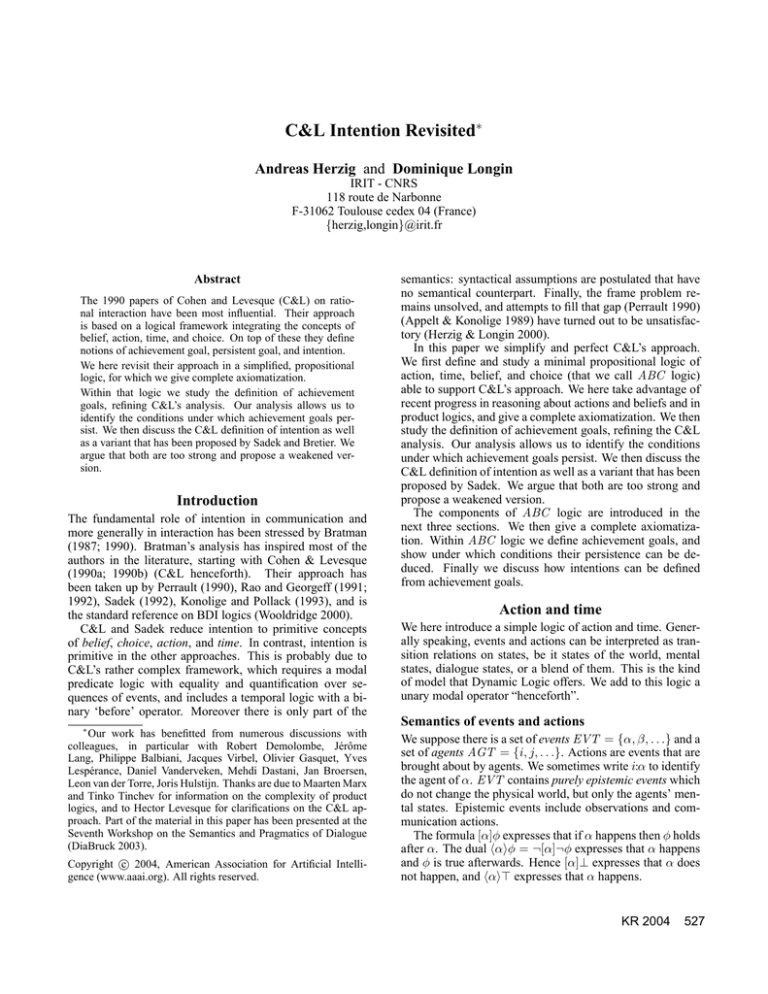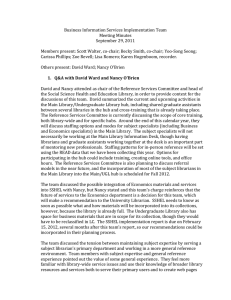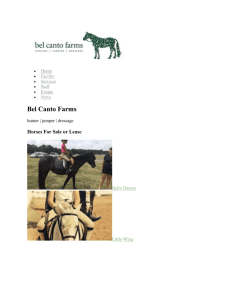
C&L Intention Revisited∗
Andreas Herzig and Dominique Longin
IRIT - CNRS
118 route de Narbonne
F-31062 Toulouse cedex 04 (France)
{herzig,longin}@irit.fr
Abstract
The 1990 papers of Cohen and Levesque (C&L) on rational interaction have been most influential. Their approach
is based on a logical framework integrating the concepts of
belief, action, time, and choice. On top of these they define
notions of achievement goal, persistent goal, and intention.
We here revisit their approach in a simplified, propositional
logic, for which we give complete axiomatization.
Within that logic we study the definition of achievement
goals, refining C&L’s analysis. Our analysis allows us to
identify the conditions under which achievement goals persist. We then discuss the C&L definition of intention as well
as a variant that has been proposed by Sadek and Bretier. We
argue that both are too strong and propose a weakened version.
Introduction
The fundamental role of intention in communication and
more generally in interaction has been stressed by Bratman
(1987; 1990). Bratman’s analysis has inspired most of the
authors in the literature, starting with Cohen & Levesque
(1990a; 1990b) (C&L henceforth). Their approach has
been taken up by Perrault (1990), Rao and Georgeff (1991;
1992), Sadek (1992), Konolige and Pollack (1993), and is
the standard reference on BDI logics (Wooldridge 2000).
C&L and Sadek reduce intention to primitive concepts
of belief, choice, action, and time. In contrast, intention is
primitive in the other approaches. This is probably due to
C&L’s rather complex framework, which requires a modal
predicate logic with equality and quantification over sequences of events, and includes a temporal logic with a binary ‘before’ operator. Moreover there is only part of the
∗
Our work has benefitted from numerous discussions with
colleagues, in particular with Robert Demolombe, Jérôme
Lang, Philippe Balbiani, Jacques Virbel, Olivier Gasquet, Yves
Lespérance, Daniel Vanderveken, Mehdi Dastani, Jan Broersen,
Leon van der Torre, Joris Hulstijn. Thanks are due to Maarten Marx
and Tinko Tinchev for information on the complexity of product
logics, and to Hector Levesque for clarifications on the C&L approach. Part of the material in this paper has been presented at the
Seventh Workshop on the Semantics and Pragmatics of Dialogue
(DiaBruck 2003).
c 2004, American Association for Artificial IntelliCopyright gence (www.aaai.org). All rights reserved.
semantics: syntactical assumptions are postulated that have
no semantical counterpart. Finally, the frame problem remains unsolved, and attempts to fill that gap (Perrault 1990)
(Appelt & Konolige 1989) have turned out to be unsatisfactory (Herzig & Longin 2000).
In this paper we simplify and perfect C&L’s approach.
We first define and study a minimal propositional logic of
action, time, belief, and choice (that we call ABC logic)
able to support C&L’s approach. We here take advantage of
recent progress in reasoning about actions and beliefs and in
product logics, and give a complete axiomatization. We then
study the definition of achievement goals, refining the C&L
analysis. Our analysis allows us to identify the conditions
under which achievement goals persist. We then discuss the
C&L definition of intention as well as a variant that has been
proposed by Sadek. We argue that both are too strong and
propose a weakened version.
The components of ABC logic are introduced in the
next three sections. We then give a complete axiomatization. Within ABC logic we define achievement goals, and
show under which conditions their persistence can be deduced. Finally we discuss how intentions can be defined
from achievement goals.
Action and time
We here introduce a simple logic of action and time. Generally speaking, events and actions can be interpreted as transition relations on states, be it states of the world, mental
states, dialogue states, or a blend of them. This is the kind
of model that Dynamic Logic offers. We add to this logic a
unary modal operator “henceforth”.
Semantics of events and actions
We suppose there is a set of events EVT = {α, β, . . .} and a
set of agents AGT = {i, j, . . .}. Actions are events that are
brought about by agents. We sometimes write i:α to identify
the agent of α. EVT contains purely epistemic events which
do not change the physical world, but only the agents’ mental states. Epistemic events include observations and communication actions.
The formula [α]φ expresses that if α happens then φ holds
after α. The dual hαiφ = ¬[α]¬φ expresses that α happens
and φ is true afterwards. Hence [α]⊥ expresses that α does
not happen, and hαi⊤ expresses that α happens.
KR 2004
527
Semantics of time
To speak about sequences of more than one event we use a
temporal operator . φ expresses that henceforth φ holds.
A dual operator ♦ is defined by ♦φ = ¬¬φ (‘eventually
φ’).
Models have a set of possible worlds W , and a mapping
V : W → (ATM → {0, 1})
associating a valuation Vw to every w ∈ W . There are mappings
R : W → 2W
and
R : EVT → (W → 2W )
associating sets of possible worlds R (w) and Rα (w) every
possible world w. We indentify such mappings with accessibility relations: wR w′ iff w′ ∈ R (w), etc. As usual,
w |= [α]φ if w′ |= φ for every w′ ∈ Rα (w)
and
w |= φ if w′ |= φ for every w′ ∈ R (w)
With C&L we suppose:
• if wRα w′ and wRβ w′′ then w′ = w′′ ;
• R is reflexive1 , transitive2 , and confluent3 ;
• if wRα w′ then wR w′ ;
• if wRα w′ , wR w′′ and w 6= w′′ then w′ R w′′ .
It follows from the last two conditions that events are organized in histories: if wRα w′ and wRβ w′′ then w′ = w′′ .
From that it follows that events are deterministic. (To see
this put β = α.)
Our semantics is slightly weaker than C&L’s. First, R
is not necessarily linear. Second, w might be possible in the
future without there being a particular sequence of actions
leading to w: φ will be eventually true without necessarily
having a sequence of actions which will achieve φ. This will
be relevant when it comes to intentions, because an agent
might believe w can be achieved without having a plan to
reach w.
Mental attitudes
We now add the basic mental attitudes of belief and choice
to the picture.
Semantics of belief
Under the doxastic logics denomination, modal logics of belief are popular in philosophy and AI, and the system KD45
is widely accepted.4 In the models, for each agent i and possible world w there is an associated set of possible worlds
Bi (w) ⊆ W : the worlds that are compatible with i’s beliefs.
1
For every w ∈ W , wR w.
If w1 R w2 R w3 then w1 R w3 .
3
If wR w1 and wR w2 then there is a w3 such that w1 R w3
and w2 R w3 .
4
The most important criticism that has been made to KD45 is
that it accepts omniscience, i.e. an agent’s beliefs are closed under
tautologies, conjunction, and logical consequences. In particular
the latter point, viz. that an agent believes all the consequences of
his beliefs, has been considered to be unrealistic. We here accept
omniscience to simplify the framework.
2
528
KR 2004
Hence every Bi is a mapping
Bi : W → 2W
For every i ∈ AGT there is a modal operator Bel i , and
Bel i φ expresses that agent i believes that φ. The truth condition for the modal operator Bel i stipulates that w |= Bel i φ
if φ holds in all worlds that are compatible with i’s beliefs,
i.e.
w |= Bel i φ if v |= Bel i φ for every v ∈ Bi (w)
Bi can be seen as an accessibility relation, and it is standard
to suppose that
• every relation Bi is serial5 , transitive, and euclidian6 .
BelIf i φ abbreviates Bel i φ ∨ Bel i ¬φ.
Semantics of choice
Among all the worlds in Bi (w) that are possible for agent i,
there are some that i prefers. C&L say that i chooses some
subset of Bi (w). Semantically, these worlds are identified
by yet another accessibility relation
Ci : W → 2W
Choice i φ expresses that agent i chooses that φ. We sometimes also say that i prefers that φ.7 Without surprises,
w |= Choice i φ if φ holds in all preferred worlds, i.e.
w |= Choice i φ if w′ |= φ for every w′ ∈ Ci (w)
We suppose that
• Ci is serial, transitive, and euclidian.
This differs from C&L, who only have supposed seriality,
and follows Sadek’s approach. The latter has argued that
choice is a mental attitude which obeys to principles of introspection that correspond with transitivity and euclideanity.
Choice and belief
What is the relation between choice and belief? As said
above, an agent only chooses worlds he considers possible:
• Ci (w) ⊆ Bi (w).
Hence belief implies choice, and choice is a mental attitude
that is weaker than belief. This corresponds to validity of
the (IncChoice i ) principle Bel i φ → Choice i φ. We moreover require that worlds chosen by i are also chosen from i’s
possible worlds, and vice versa:
• if wBi w′ then Ci (w) = Ci (w′ ).
(See Figure 1.)
Such a semantics validates the equivalences
Choice i φ ↔ Bel i Choice i φ
(1)
¬Choice i φ ↔ Bel i ¬Choice i φ
(2)
Choice i φ ↔ Choice i Choice i φ
(3)
¬Choice i φ ↔ Choice i ¬Choice i φ
(4)
The implication Choice i Bel i φ → Choice i φ is also valid,
but not the converse.
5
For every w ∈ W , Bi 6= ∅
for all w ∈ W , if v, v ′ ∈ Bi (w) then v ′ ∈ Bi (v) and v ∈
Bi (v ′ ).
7
While C&L use a modal operator ‘goal’ (probably in order
to have a uniform denomination w.r.t. the different versions of
goals they study), it seems more appropriate to us to use the term
‘choice’.
6
B
C
i
i
w
Figure 1: Belief and choice
The kinematics of mental attitudes
Several proposals were made in the beginning of the 90s
concerning the relation between action and belief. They
built on what was state of the art in the reasoning-aboutactions field in the 80s, and used complex default or autoepistemic logics (Perrault 1990; Appelt & Konolige 1989).
In the beginning of the 90s, Scherl and Levesque (1993)
have proposed simple principles that can be integrated easily
into the original C&L framework, which is what we undertake here.
We first make some hypotheses on the perception of
events. Then we state general principles governing relationships between belief, choice, action and time.
Hypotheses on perception
We suppose that an event occurs iff every agent i perceives
it. More precisely, we suppose that i’s perception is correct
(in the sense that if i believes that α has occurred then α indeed occurred) and complete (in the sense that if α occurs
then α is perceived by i). Hence event occurrences are public.
H YPOTHESIS . All event occurrences are perceived correctly
and completely by every agent.
We note that this hypothesis just aims at simplifying our
exposition, and that misperception can be integrated following ideas of Bacchus et al. (1995; 1999) and Baltag et col.
(1998; 2000).
While an agent perceives the occurrence of an event, or
more precisely of an event token, we suppose that he does
not learn anything beyond that about the event’s particular
effects. We therefore define uninformative events as event
tokens whose outcome is not perceived by the agents. When
an agent learns that such an event has occurred, he is nevertheless able to predict its results according to the action
laws he believes to hold. Consider e.g. the action of tossing
a coin. Suppose the agent learns that toss has occurred. As
he cannot observe the effects, he predicts them in an a priori
way, according to his mental state and the action laws. The
agent might thus be said to ‘mentally execute’ toss. After
toss he believes that Heads ∨ Tails holds, but neither believes Heads nor Tails. It is only the observation that the
coin fell heads which may make the agent start to believe
that Heads.
We suppose the observation of φ never occurs when φ is
false. To learn that the observation of φ has occurred means
to learn that φ (supposing observations are reliable). Thus,
observation actions are uninformative: all the relevant information is encoded in the notification of the event occurrence.
Then to take into account the observation of φ amounts to
incorporate φ into Bi (w).
In the same way, we can suppose that i’s action of informing that φ is uninformative (both for the speaker i and
the hearer). There are perception actions which do not satisfy our hypothesis, such as testing-if-φ. Such tests can nevertheless be reduced to uninformative actions: testing-if-φ
is the nondeterministic composition of observing-that-φ and
observing-that-¬φ.
H YPOTHESIS . All events are uninformative.
Our second hypothesis is deeper than the first: without presenting a formal proof here, we suppose that every event can be constructed from uninformative events by
means of dynamic logic nondeterministic composition “∪”
and sequencing “;”. For example the everyday action of
tossing corresponds to the complex toss; (observeHeads ∪
observeTails). In fact such a hypothesis is often made in
reasoning about actions, e.g. in (Scherl & Levesque 1993)
or (Shapiro et al. 2000, footnote 10).
Mental attitudes and action
Suppose the actual world is w, and some event α occurs
leading to a new actual world w′ . Which worlds are possible
for agent i at w′ ? According to Moore (1985) and Scherl
and Levesque (1993; 2003), i makes ‘mentally happen’ α
in all his worlds v ∈ Bi (w), and then collects the resulting
worlds Rα (v) to form the new
S belief state. We thus have
Bi (w′ ) = (Rα ◦ Bi )(w) = v∈Bi (w) Rα (v). This identity
must be restricted in order to keep i’s beliefs consistent, i.e.
to avoid Bi (w′ ) = ∅. We thus obtain:
• If wRα w′ and (Rα ◦ Bi )(w) 6= ∅
then Bi (w′ ) = (Rα ◦ Bi )(w).
This relies on our hypothesis that events are uninformative:
apart from the mere occurrence of α agent i should learn
nothing about α’s particular effects that obtain in w′ , and
Bi (w′ ) only depends on Bi (w) and α.
Note that such an explanation is in accordance with our
hypotheses. Syntactically, this makes the principle of no
forgetting (NFBel i ) Bel i [α]φ ∧ ¬Bel i [α]⊥ → [α]Bel i φ
valid, as well as the dual principle of no learning (NLBel i )
[α]Bel i φ ∧ ¬[α]⊥ → Bel i [α]φ.
How do an agent’s choices evolve? We recall that for each
possible world there is an associated temporal structure (its
history). Therefore agent i’s choices concern not only possible states of the world, but also possible histories. We therefore suppose that i’s preferences after α are just the images
KR 2004
529
R
R
B
• if wBi v then (R ◦ Bi )(v) = (Bi ◦ R )(v)
R
a
a
a
B
i
R
w
a
i
Similar to belief we impose for choice:
w '
• if wCi v then (R ◦ Ci )(v) = (Ci ◦ R )(v)
Figure 2: Action and belief
by α of its preferred worlds before α. Just as for belief, this
identity must be restricted in order to keep i’s choices consistent. We thus obtain the constraint:
• If wRα w′ and (Rα ◦ Ci )(w) 6= ∅
then Ci (w′ ) = (Rα ◦ Ci )(w).
R
R
a
R
B
C
i
a
a
B
i
R
w
a
C
i
i
w '
Figure 3: Action, belief, and choice
Again, note that such an explanation is in accordance with
our hypotheses. Syntactically, this makes valid the principle
(NFChoice i ) Choice i [α]φ ∧ ¬Choice i [α]⊥ → [α]Choice i φ,
and (NLChoice i ) [α]Choice i φ ∧ ¬[α]⊥ → Choice i [α]φ.
Mental attitudes and time
Which constraints can be formulated on Bel i and ?
First, note that from (NFBel i ) it follows that Bel i φ ∧
¬Bel i [α]⊥ → [α]Bel i φ, i.e. beliefs about invariants persist as long as there are no surprises.
What about a ‘no forgetting’ principle for the temporal
operator Bel i φ → Bel i φ? In fact this would be too
strong: suppose that for some reason, i wrongly believes
that some object is broken and cannot be repaired. We thus
have Bel i ¬Broken, which together with such a principle
would imply Bel i ¬Broken. Which is absurd: imagine
e.g. i learns that the object is in fact not broken. Then such
a no forgetting principle would forbid any belief revision.
Only weaker identities can be motivated here: for each of
i’s possible worlds v, if u′ is possible for i in some world u
in the future of v then there is a world v ′ possible for i such
that u′ is in its future. And vice versa:
530
KR 2004
This constraint can also be interpreted as a form of introspection through time. Indeed, the introspection principles
for belief correspond to Bi ◦ Bi = Bi , and it can be shown
that due to transitivity and euclideanity of Bi our condition is
equivalent to Bi ◦R ◦Bi = Bi ◦R . Note that corresponding principles of negative introspection cannot be motivated.
This
makes
the
principle
(InvChoice i )
Choice i (Choice i φ ↔ Choice i φ) valid. It follows
that Choice i Choice i φ ↔ Choice i φ, which says that if
an agent prefers φ to be invariant then he chooses that he
will always prefer φ, and vice versa.
Comments: revision of beliefs and choices
Our conditions say nothing about i’s beliefs after a surprising action occurrence, i.e. when (Rα ◦ Bi )(w) = ∅. In this
case i must revise his beliefs. Integrations of belief revision into a logic of action and belief have been proposed in
(Shapiro et al. 2000). In (Herzig & Longin 2002) we have
proposed an alternative based on updating by the preconditions of α. It amounts to suppose that our language contains
not only modal action operators [α], but also update operators [upd (φ)], for every formula φ. In the original paper
such operations were seen as particular actions. Here we
have to separate them because our semantics is in terms of
histories, and at most one action happens at a given w, while
we would like to allow several updates leaving w.
Our conditions do not constrain either i’s choices when
(Rα ◦ Ci )(w) = ∅, i.e. after an unwanted action occurrence.
Then i has to revise his choices.
There are two cases. First, if Choice i [α]⊥ and Bel i [α]⊥
then a surprising event has occurred, and the agent has to
revise both his beliefs and his choices. We think that in
this case our account of belief revision in (Herzig & Longin 2002) can be extended to choice revision. In the second
case we have Choice i [α]⊥ and ¬Bel i [α]⊥. Then i did not
believe the event was impossible, but preferred so. Devices
such as a preference relation have to be integrated here, and
we leave a more detailed investigation to future work.
Completeness theorem
We have defined the semantics of a basic logic of action, belief, and choice. To sum it up, our models have the form
hW, B, C, R, R , V i, where W is a set of possible worlds,
B and C associate accessibility relations to every agent, R
associates an accessibility relation to every action, R is
the accessibility relation for , and V associates a valuation to every possible world. We call ABC models the set
of models satisfying all the constraints imposed in the three
preceding sections, and write |=ABC φ if φ is valid in ABC
models. We write S |=ABC φ if φ is a logical consequence
of the set of formulas S in ABC models.
We give now an axiomatization of ABC . We suppose the
axioms and inference rules of the basic normal modal logic
K for every modal operator,8 plus the following:
¬(Bel i φ ∧ Bel i ¬φ)
Bel i φ → Bel i Bel i φ
¬Bel i φ → Bel i ¬Bel i φ
¬(Choice i φ ∧ Choice i ¬φ)
Choice i φ → Bel i Choice i φ
¬Choice i φ → Bel i ¬Choice i φ
Bel i φ → Choice i φ
φ → φ
φ → φ
♦φ → ♦φ
φ → [α]φ
hαiφ → [β]φ
♦φ → (φ ∨ [α]♦φ)
Bel i [α]φ ∧ ¬Bel i [α]⊥ → [α]Bel i φ
[α]Bel i φ ∧ ¬[α]⊥ → Bel i [α]φ
Choice i [α]φ ∧ ¬Choice i [α]⊥ →
[α]Choice i φ
[α]Choice i φ ∧ ¬[α]⊥ → Choice i [α]φ
Bel i (Bel i φ ↔ Bel i φ)
Choice i (Choice i φ ↔ Choice i φ)
From (InvBel i ) it can be deduced in KD45 that
(DBel i )
(4Bel i )
(5Bel i )
(DChoice i )
(PIChoice i )
(NIChoice i )
(IncChoice i )
(T)
(4)
(Confl)
(Inc[α])
(Hist1)
(Hist2)
(NFBel i )
(NLBel i )
(NFChoice i )
(NLChoice i )
(InvBel i )
(InvChoice i )
Some comments are in order.
(PIChoice i ) is an axiom of positive introspection for
choice similar to (4Bel i ) and (NIChoice i ) is the negative version.
Axiom (Hist1) implies determinism of every α: hαiφ →
[α]φ. (Hist2) is similar to the first of the Segerberg axioms
(Harel 1984).
Axioms (NFBel i ) and (NLBel i ) can be put together
into the single (¬[α]⊥ ∧ ¬Bel i [α]⊥) → ([α]Bel i φ ↔
Bel i [α]φ). Equivalences of this kind have been called successor state axioms for belief in (Scherl & Levesque 1993).
(NFChoice i ) and (NLChoice i ) are their analogues for
choice. Such axioms for choice have not been studied before.
(InvBel i ) is a subjective version of a successor state axiom
for belief and time. (InvChoice i ) is a similar axiom for choice
and time. As far as we know they have not been studied
before either.
From (NFBel i ) it follows that
Bel i φ ∧ ¬Bel i [α]⊥ → [α]Bel i φ,
i.e. beliefs about invariants persist as long as there are no
surprises.
8
for example for [α]:
from φ ↔ ψ infer [α]φ ↔ [α]ψ
[α](φ ∧ ψ) → [α]φ ∧ [α]ψ
[α]φ ∧ [α]ψ → [α](φ ∧ ψ)
[α]⊤
(RE[α])
(M[α])
(C[α])
(N[α])
Bel i φ ↔ Bel i Bel i φ
i.e. if i believes φ to be an invariant then he believes that he
will always be aware of φ.
Moreover,
Bel i (Bel i φ → φ)
Bel i ♦Bel i φ → Bel i ♦φ
Choice i ♦Bel i φ → Choice i ♦φ
are valid.
The other way round, Bel i ♦φ → Bel i ♦Bel i φ and
Choice i ♦φ → Choice i ♦Bel i φ should not hold. Here is
an example illustrating that, inspired by Heisenberg’s uncertainty principle. Let p mean that some electron is in a
particular place. Suppose you believe that it will eventually
be in that place: Bel i ♦p. According to Heisenberg it is impossible to know that at the same point in time: ¬Bel i p.
Now if we suppose that i is aware of that principle, we obtain Bel i ¬♦Bel i p.
A similar argument can be made against Choice i ♦φ →
Choice i ♦Bel i φ. This is opposed to Sadek and colleagues’
approach (Sadek 1992; Bretier 1995; Louis 2003), where the
principle Choice i ♦φ → Choice i ♦Bel i φ is accepted.
We call ABC logic the logic thus axiomatized, and write
⊢ABC φ if φ is a theorem of ABC .
T HEOREM . |=ABC φ
iff
⊢ABC φ.
It is a routine task to check that all the axioms correspond to their semantic counterparts. It is routine, too, to
check that all of our axioms are in the Sahlqvist class, for
which a general completeness result exists (Sahlqvist 1975;
Blackburn, de Rijke, & Venema 2001).
We conjecture that Marx’s proof (1999) of decidability
and EXPSPACE complexity of the problem of satisfiability in the product logic S5×K extends straightforwardly to
ABC logic in the case of a single agent.9
In the rest of the paper, we apply ABC logic to investigate the notions of achievement goal, persistent goal, and
intention.
Achievement goals
C&L view goals and intentions as particular future-oriented
choices which take the form Choice i ♦φ.
If φ is already believed to be true then there is no point
in maintaining the goal or the intention that φ. C&L therefore concentrate on goals which require some change in order to make them true. Basically such goals are of the form
Choice i ♦φ∧¬ψ, where ψ is a condition triggering the abandonment of the goal.
Which forms do φ and ψ take? First of all φ and ψ should
be equivalent: when φ obtains then the goal can be abandoned, and whenever the goal is abandoned then φ holds.
9
We are indebted to Maarten Marx for pointing this out.
KR 2004
531
(This is at least expected by i.) Second, ψ should not be factual, but rather about i’s mental state: else the agent has no
means to decide when to abandon his goal. Hence achievement goals take the following form.
D EFINITION . Agent i has the achievement goal that φ if (1)
in his preferred worlds φ is believed later and (2) i does not
believe φ:
def
AGoal i φ = Choice i ♦Bel i φ ∧ ¬Bel i φ
(DefAGoal i )
The only basic modal principle our definition of achievement goals validates is
φ↔ψ
.
AGoal i φ ↔ AGoal i ψ
For the rest, just as in the C&L account none of the standard
principles is valid.
The so-called side effect problem is to avoid to systematically adopt the consequences of our goals. Formally
AGoal i φ ∧ Bel i (φ → ψ) → AGoal i ψ should not be valid.
Just as for C&L, this formula is not valid in ABC logic.
Even if we strengthen the condition Bel i (φ → ψ) in various ways, AGoal i φ does not imply AGoal i ψ. The reason
is that the side effect might be believed, which makes that ψ
cannot be an achievement goal. And just as C&L, if we add
the condition ¬Bel i ψ then we validate
AGoal i φ ∧ Bel i (φ → ψ) ∧ ¬Bel i ψ → AGoal i ψ.
(The proof makes use of the Axiom (InvBel i ).) We also validate and the inference rule
φ→ψ
.
AGoal i φ ∧ Bel i ∧ ¬Bel i ψ → AGoal i ψ
Finally, the valid equivalences
AGoal i φ ↔ Bel i AGoal i φ
and
¬AGoal i φ ↔ Bel i ¬AGoal i φ
express that an agent is aware of his achievement goals. The
equivalence
AGoal i φ ↔ AGoal i Bel i φ
is valid as well (while only the left-to-right direction is valid
for C&L).
Comparison with C&L
C&L’s original definition of achievement goals is
def
AGoal CL
i φ = Choice i ♦φ ∧ Bel i ¬φ.
T HEOREM . AGoal i φ ↔ AGoal CL
i Bel i φ.
This can be proved using introspection properties of belief.
532
KR 2004
C&L satisfy Axiom D: ¬(AGoal i φ ∧ AGoal i ¬φ), while
we do not.10 Thus, while an agent’s choices are consistent,
his achievement goals are not necessarily so. This can be
justified by the same temporal considerations that lead to rejection of axiom C: i might want φ to be true at some point in
the future, and φ to be false at some other point in the future.
But note that AGoal i φ ∧ AGoal i ¬φ is unsatisfiable due
to the confluence of time.
In their definition, C&L stipulate that i should believe φ
is false. We have preferred the weaker ¬Bel i φ because it
is more natural: in general goals are abandoned only when
they are believed to be true, and therefore absence of belief is sufficient to maintain the goal (but see our Byzantine
example below for a counterexample).
C&L only require Choice i ♦φ. We have seen in the previous section that Choice i ♦Bel i φ → Choice i ♦φ is a theorem. We have also said there that the other sense of the
implication should not hold. So let us consider a situation
where Choice i ♦φ ∧ ¬Choice i ♦Bel i φ holds. The following
example seems to motivate the need for achievement goals
in C&L’s sense.
Let r mean that a message of i has been received by
j, and let i believe initially that j has not received the
message yet. Suppose we are in a Byzantine-generalsstyle scenario where i is not guaranteed that his message
will eventually be received by j, and where i believes
that in any case he will never know whether j received
the message or not. (In the original scenario it is just
possible for i that he will never know.) Hence we have
Bel i ¬r ∧ Choice i ♦r ∧ Bel i ¬BelIf i r. From the latter
it follows that ¬Choice i ♦Bel i r. In summary, we have
Bel i ¬r ∧ AGoal CL
i r ∧ ¬AGoal i r.
Now in such a context it seems reasonable that i acts by
nevertheless posting the message. C&L can account for this
case by stating AGoal CL
i r. What would be i’s achievement
goal in our account? We argue that in the example i has
the achievement goal that ¬Bel i ¬r: such an achievement
goal can first motivate i to post the message, and then trigger abandonment (say after the time period i esteems necessary for the message travelling under favorable conditions).
Note that AGoal i ¬Bel i ¬r is consistent with the scenario
description.
Consider another example where there is only one action
of toggling a switch, and suppose that in the initial world
w0 |= ¬Bel i Light ∧ ¬Bel i ¬Light, i.e. i ignores whether
the light is on or off: for i there is at least one possible world
where Light holds, and there is at least one possible world
where ¬Light holds. As toggling is the only available action
we have w0 |= Bel i (¬Bel i Light ∧ ¬Bel i ¬Light), i.e.
i believes he will always ignore whether the light is on or
off. According to C&L agent i can nevertheless have the
10
As C&L’s admit, this is ‘for the wrong reasons’: their stronger
definition of achievement goals is responsible for AGoal i φ →
Bel i ¬φ, which warrants axiom D for AGoal i . Note that
they do not validate the stronger but equally intuitive principle
¬(φ∧ψ)
. Apparently this has not been noted in the
¬(AGoal i φ∧AGoal i ψ)
literature.
achievement goal AGoal CL
i Light in w0 , while he cannot
have such a goal with our definition. Thus i is aware that
he will never be able to abandon his goal that Light in the
expected way, viz. by coming to believe that Light.
Persistent goals
C&L have defined persistent goals to be achievement goals
that are kept until they are achieved, or are abandoned for
some other reasons. We can show that persistence can be
deduced from our no forgetting principle for choice as long
as the event is not unwanted:
T HEOREM .
|=ABC (AGoal i φ ∧ ¬Choice i [α]⊥)
[α](AGoal i φ ∨ Bel i φ)
→
P ROOF.
We prove ¬Bel i φ ∧ Choice i ♦Bel i φ →
Choice i [α]⊥ ∨ [α]Choice i ♦Bel i φ. This can be deduced
from (NLChoice i ), (Hist2), (IncChoice i ) as follows.
First, axiom (Hist2) tells us that
♦Bel i φ → (Bel i φ ∨ [α]♦Bel i φ)
for any action α. Therefore
Choice i ♦Bel i φ → Choice i (Bel i φ ∨ [α]♦Bel i φ).
As by (5Bel i ) and (IncChoice i ) we have
¬Bel i φ → Choice i ¬Bel i φ,
the left hand side implies
Choice i [α]♦Bel i φ.
From that we get with (NLChoice i ) that
Choice i [α]⊥ ∨ [α]Choice i ♦Bel i φ.
We inherit the properties of achievement goals concerning
logical principles, the side effect problem, and persistence.
Comparison with C&L
C&L’s original definition is that a persistent goal that φ is an
achievement goal that φ that can only be abandoned if
1. φ is achieved, or
2. the agent learns that φ can never be achieved, or
3. for some other reason.
This leads to their principle
PGoal i φ → [α](PGoal i φ ∨ Bel i φ ∨ Bel i ¬φ ∨ ψ),
where ψ is an unspecified condition accounting for case
(3). Our theorem makes (3) more precise by identifying it
with the occurrence of an unwanted event, which is the only
case when achievement goals have to be revised.11 Indeed,
the theorem tells us that C&L’s case (2) is excluded when
¬Choice i [α]⊥ holds: in this case we are guaranteed that
i will not learn through α that φ will be false henceforth.
Given our hypothesis that events are uninformative, this is
as it should be.
11
In the case where i is the agent of α (noted i : α) one might
reasonably suppose that Choice i [i:α]⊥ → [i:α]⊥, i.e. there are
no such unwanted action occurrences. We then get unconditioned
persistence of achievement goals: AGoal i φ → [i:α](AGoal i φ ∨
Bel i φ). This is related to intentional actions as discussed in C&L’s
(1990a, section 4.2.1), where moreover Bel i [i:α]⊥ ∨ Bel i ¬[i:α]⊥
is assumed. We just note that such principles are of the Sahlqvist
type, and can be added to ABC logic without harm.
Intentions
C&L have distinguished intentions-to-do and intentions-tobe. We here only consider the latter, which, following Bratman, C&L have defined as particular persistent goals: the
agent must be committed to achieve the goal, in the sense
that he must believe that he will perform an action which
will lead to the goal.
D EFINITION . Agent i has the intention that φ if (1) i has the
achievement goal that φ, and (2) i does not believe Bel i φ
will obtain anyway:
def
Int i φ = AGoal i φ ∧ ¬Bel i ♦Bel i φ
(DefInt i )
Hence intentions are achievement goals which do not
automatically obtain in the future. As ¬Bel i ♦Bel i φ implies ¬Bel i φ, it follows that Int i φ ↔ Choice i ♦Bel i φ ∧
¬Bel i ♦Bel i φ. If not explicitly, this implicitly links i’s intending that φ to i’s choosing actions that get him closer to
φ: Int i φ triggers i’s planning for φ. Therefore it seems justified to say that our definition captures the spirit of Bratman’s
intentions.
What is the status of achievement goals when
Bel i ♦Bel i φ holds? In this case, AGoal i φ ∧ Bel i ♦Bel i φ is
equivalent to Bel i ♦Bel i φ ∧ ¬Bel i φ: i believes φ will be
achieved in the future, no matter what continuation of his
possible histories occurs. Then according to our definition i
has to abandon Int i φ at w1 . This is reminiscent of McDermott’s Little Nell example: suppose that i intends that φ at
w0 , and that i successfully plans and acts in a way such that
later on at w1 he is sure φ will be achieved in the future,
i.e. Bel i ♦Bel i φ holds at w1 . According to McDermott
i then abandons his intention that φ too early, and will
never achieve φ. We believe the problem can be solved
by separating planning-oriented (future-oriented) intention
from intention-in-action: at w1 agent i switches from the
planning-oriented intention Int i φ to the intention-in-action
to execute the plan (alias complex action) which he believes
ensures that φ will obtain. i will stick to this plan from w1
on and as long as no unforeseen events occur.12
Again, we inherit the properties of achievement goals
concerning logical principles, the side effect problem, and
in particular persistence:
T HEOREM .
|=ABC (Int i φ ∧ ¬Choice i [α]⊥)
[α](Int i φ ∨ Bel i ♦Bel i φ)
→
P ROOF. The theorem of the previous section establishing
that achievement goals are also persistence goals, a look at
the proof tells us that
(AGoal i φ ∧ ¬Choice i [α]⊥) → [α]Choice i ♦Bel i φ
Therefore by classical principles
(AGoal i φ ∧ ¬Choice i [α]⊥) →
[α]((Choice i ♦Bel i φ ∧ ¬Bel i ♦Bel i φ) ∨ Bel i ♦Bel i φ)
12
We could pursue this and define future-directed intention-todo α as Choice i ♦hi:αi⊤.
KR 2004
533
from which the present theorem follows by the definition of
intention.
Hence intentions persist as long as there are no unwanted
action occurrences.
Comparison with C&L
Our definition of Int i φ differs from C&L’s in a fundamental way because it does not mention actions: C&L basically
stipulate that in every preferred history there must be some
action α whose author is i and which brings about φ.
Using quantification over actions this could be approximated by:
def
Int CL
i φ = ¬Bel i φ ∧ Choice i ♦∃i:αhi:αiBel i φ.
But as pointed out by Sadek (2000) and Bretier (1995),
such a definition is too strong in particular in cooperative
contexts, where it often suffices for i to trigger actions of
some other agent j which will achieve the goal. They have
advocated a correction, which we roughly approximate here
by:
def
Int Si φ = ¬Bel i φ ∧ Choice i ♦Bel i φ∧
Choice i ∀i:α(Bel i hi:αi♦Bel i φ → Choice i ♦hi:αi⊤).
Again, this is too strong: my intention to go to Vancouver
in june here would force me to choose the action of hiring
an aircraft. In another sense, both C&L’s and Sadek’s definitions are too weak because they lack a causal connection
between the action and the goal: basically they entitle me to
entertain the intention that it be sunny in Vancouver in june
if each of my preferred histories has some action of mine
leading to a state where this holds.
As our definition of intention does not mention events at
all, this example also illustrates that our definition is also too
weak in this respect.
Conclusion
We have integrated action, time, belief, and choice in a simple propositional modal logic that is sound, complete and
decidable, and which we think provides the basic framework
for the logical analysis of interaction. We have shown how
different notions of goal and intention can be expressed in it,
and have identified the conditions under which such motivational attitudes persist.
Although Cohen and Levesque’s papers are standard references, to the best of our knowledge such a simplification
has never been undertaken. Our completeness, decidability
and complexity results pave the way for methods of mechanical deduction.
In ABC logic we have also in part solved the frame problem for belief and intention. While the frame problem for
belief has been investigated extensively in the literature,
there is not too much work in the literature on the frame
problem for intentions, and the only references we are aware
of are (Shapiro & Lespérance 2000; Shapiro, Lespérance, &
Levesque 1997; 1998). These accounts are preliminary, in
particular they lead to fanatic agents.
534
KR 2004
What is lacking for a comprehensive solution to the
frame problem for intention is the integration of belief and
choice revision (sometimes called intention reconsideration
in agent theories (Thomason 2000; Schut & Wooldridge
2001)). We leave this important issue to future work.
What remains also to be addressed is the question of how
intentions lead to actions. This is is the topic of plan generation, which still has to be integrated in our logic.
References
Appelt, D., and Konolige, K. 1989. A nonmonotonic logic
for reasoning about speech acts and belief revision. In Reinfrank, M.; de Kleer, J.; Ginsberg, M.; and Sandewall, E.,
eds., Proc. 2nd Int. Workshop on Non-monotonic Reasoning, number 346 in LNAI, 164–175. Springer Verlag.
Bacchus, F.; Halpern, J.; and Levesque, H. 1995. Reasoning about noisy sensors in the situation calculus. In Proc.
14th Int. Joint Conf. on Artificial Intelligence (IJCAI’95),
1933–1940.
Bacchus, F.; Halpern, J.; and Levesque, H. 1999. Reasoning about noisy sensors in the situation calculus. Artificial
Intelligence 111:131–169.
Baltag, A.; Moss, L. S.; and Solecki, S. 1998. The logic
of public announcements, common knowledge, and private
suspicions. In Proc. TARK’98, 43–56. Morgan Kaufmann.
Baltag, A. 2000. A logic of epistemic actions. Technical report, CWI. http://www.cwi.nl/∼abaltag/
papers.html.
Blackburn, P.; de Rijke, M.; and Venema, Y. 2001. Modal
Logic. Cambridge Tracts in Theoretical Computer Science.
Cambridge University Press.
Bratman, M. E. 1987. Intentions, plans, and practical
reason. Harvard University Press, MA.
Bratman, M. E. 1990. What is intention? In Cohen, P. R.;
Morgan, J.; and Pollack, M. E., eds., Intentions in Communication. Cambridge, MA: MIT Press. chapter 2, 15–31.
Bretier, P. 1995. La communication orale coopérative :
contribution à la modélisation logique et à la mise en œuvre d’un agent rationnel dialoguant. Ph.D. Dissertation,
Université Paris Nord, Paris, France.
Cohen, P. R., and Levesque, H. J. 1990a. Intention is choice
with commitment. Artificial Intelligence J. 42(2–3):213–
261.
Cohen, P. R., and Levesque, H. J. 1990b. Persistence, intentions, and commitment. In Cohen, P. R.; Morgan, J.; and
Pollack, M. E., eds., Intentions in Communication. Cambridge, MA: MIT Press. chapter 3, 33–69.
Harel, D. 1984. Dynamic logic. In Gabbay, D. M., and
Günthner, F., eds., Handbook of Philosophical Logic, volume II. D. Reidel, Dordrecht. 497–604.
Herzig, A., and Longin, D. 2000. Belief dynamics in cooperative dialogues. J. of Semantics 17(2). vol. published
in 2001.
Herzig, A., and Longin, D. 2002. Sensing and revision in a
modal logic of belief and action. In van Harmelen, F., ed.,
Proc. ECAI2002, 307–311. IOS Press.
Konolige, K., and Pollack, M. E. 1993. A representationalist theory of intention. In Proc. 13th Int. Joint Conf.
on Artificial Intelligence (IJCAI’93), 390–395. Chambery,
France: Morgan Kaufmann.
Louis, V. 2003. Conception et mise en œuvre de modles formels du calcul de plans d’action complexes par un
agent rationnel dialoguant. Ph.D. Dissertation, Université
de Caen, France.
Marx, M. 1999. Complexity of products of modal logics.
J. of Logic and Computation 9(2):221–238.
Moore, R. C. 1985. A formal theory of knowledge and
action. In Hobbs, J., and Moore, R., eds., Formal Theories
of the Commonsense World. Norwood, NJ: Ablex. 319–
358.
Perrault, C. R. 1990. An application of default logic
to speech act theory. In Cohen, P. R.; Morgan, J.; and
Pollack, M. E., eds., Intentions in Communication. Cambridge, MA: MIT Press. chapter 9, 161–185.
Rao, A. S., and Georgeff, M. P. 1991. Modeling rational
agents within a BDI-architecture. In Allen, J. A.; Fikes, R.;
and Sandewall, E., eds., Proc. 3rd Int. Conf. on Knowledge
Representation and Reasoning (KR’91), 473–484. San Mateo, CA: Morgan Kaufmann.
Rao, A. S., and Georgeff, M. P. 1992. An abstract architecture for rational agents. In Nebel, B.; Rich, C.; and
Swartout, W., eds., Proc. 4th Int. Conf. on Knowledge Representation and Reasoning (KR’92), 439–449. Cambridge,
Massachusetts: Morgan Kaufmann.
Sadek, M. D. 1992. A study in the logic of intention.
In Nebel, B.; Rich, C.; and Swartout, W., eds., Proc. 4th
Int. Conf. on Knowledge Representation and Reasoning
(KR’92), 462–473. Cambridge, Massachusetts: Morgan
Kaufmann.
Sadek, M. D. 2000. Dialogue acts are rational plans.
In Taylor, M.; Nel, F.; and Bouwhuis, D., eds., The
structure of mutimodal dialogue, 167–188. Philadelphia/Amsterdam: John Benjamins publishing company.
From ESCA/ETRW, Workshop on The Structure of Multimodal Dialogue (Venaco II), 1991.
Sahlqvist, H. 1975. Completeness and correspondence in
the first and second order semantics for modal logics. In
Kanger, S., ed., Proc. 3rd Scandinavian Logic Symposium
1973, number 82 in Studies in Logic. North Holland.
Scherl, R., and Levesque, H. J. 1993. The frame problem
and knowledge producing actions. In Proc. Nat. Conf. on
AI (AAAI’93), 689–695. AAAI Press.
Scherl, R., and Levesque, H. J. 2003. The frame problem
and knowledge producing actions. Artificial Intelligence
144(1-2).
Schut, M., and Wooldridge, M. 2001. Principles of intention reconsideration. In Proc. AGENTS’01. ACM Press.
Shapiro, S., and Lespérance, Y. 2000. Modeling multiagent
systems with the cognitive agents specification language - a
feature interaction resolution application. In Castelfranchi,
C., and Lespérance, Y., eds., Intelligent Agents Vol. VII
- Proc. 2000 Workshop on Agent Theories, Architectures,
and Languages (ATAL-2000). Springer-Verlag.
Shapiro, S.; Pagnucco, M.; Lespérance, Y.; and Levesque,
H. J. 2000. Iterated belief change in the situation calculus.
In Proc. KR2000, 527–538.
Shapiro, S.; Lespérance, Y.; and Levesque, H. J. 1997.
Specifying communicative multi-agent systems with ConGolog. In Working notes of the AAAI fall symposium on
Communicative Action in Humans and Machines, 75–82.
AAAI Press.
Shapiro, S.; Lespérance, Y.; and Levesque, H. J.
1998. Specifying communicative multi-agent systems. In
Wobcke, W.; Pagnucco, M.; and Zhang, C., eds., Agents
and Multi-Agent Systems - Formalisms, Methodologies,
and Applications, 1–14. Springer-Verlag, LNAI 1441.
Thomason, R. H. 2000. Desires and defaults: A framework for planning with inferred goals. In Proc. of the Seventh International Conference Knowledge Representation
and Reasoning (KR’2000), 702–713. Morgan Kaufmann
Publishers.
Wooldridge, M. 2000. Reasonning about Rational Agent.
Cambridge, Massachusetts: MIT Press.
KR 2004
535







